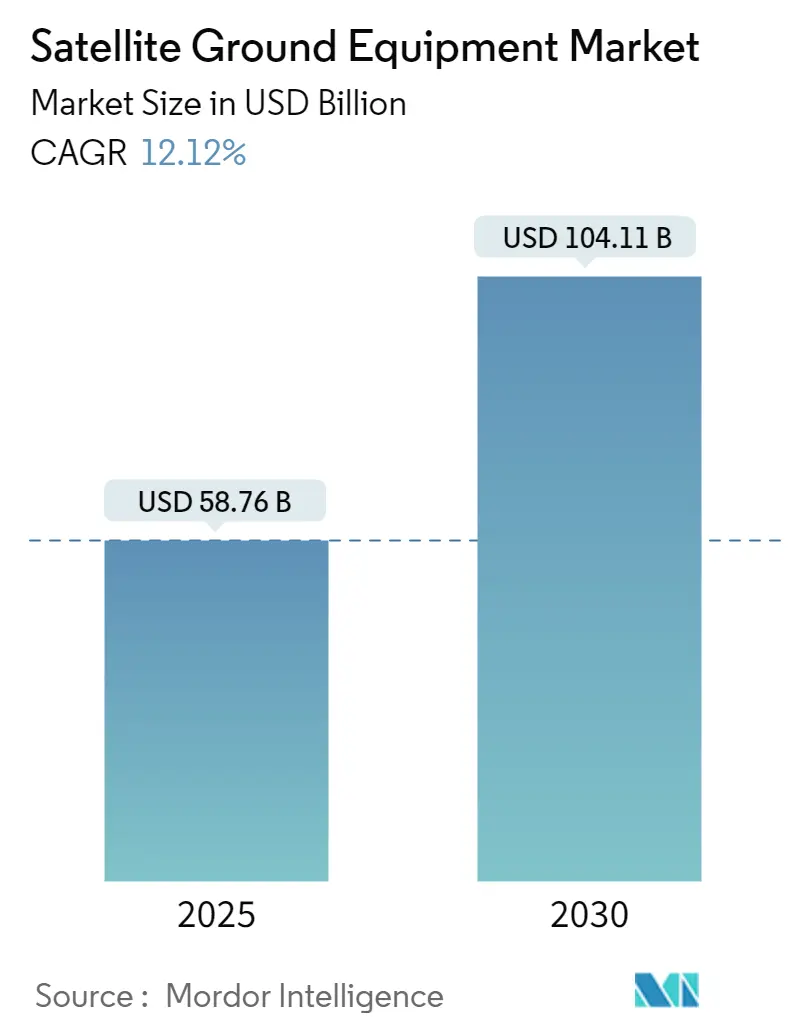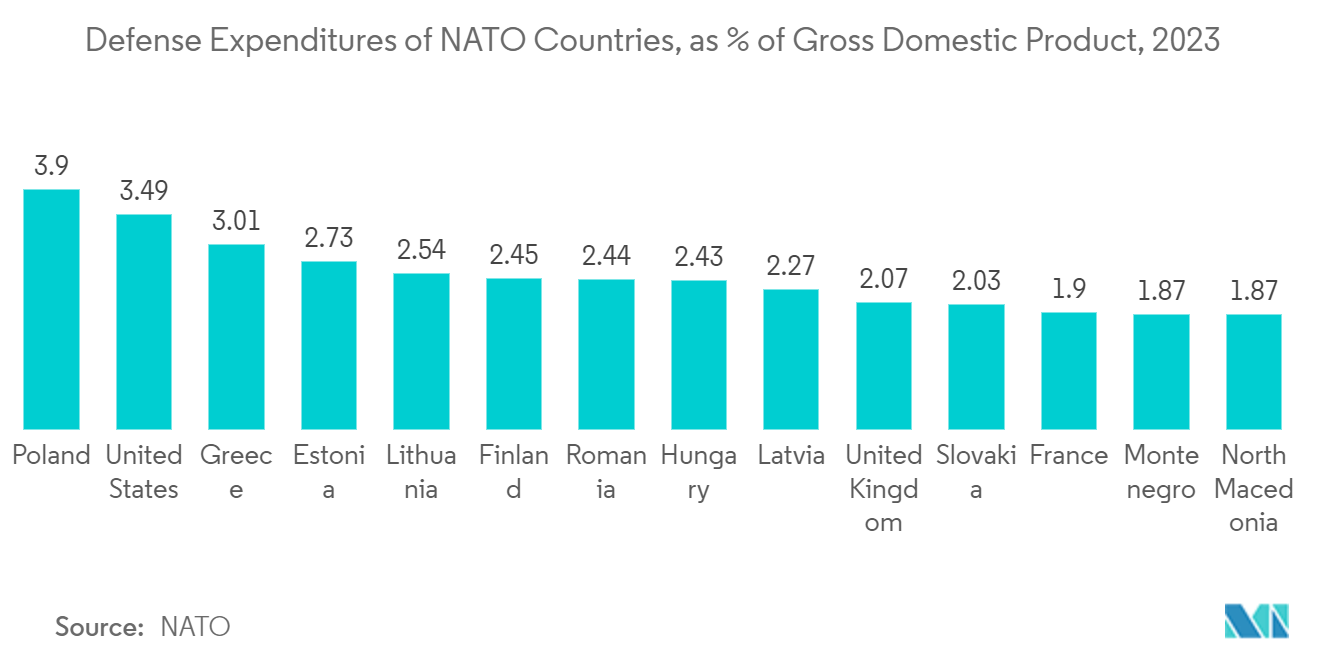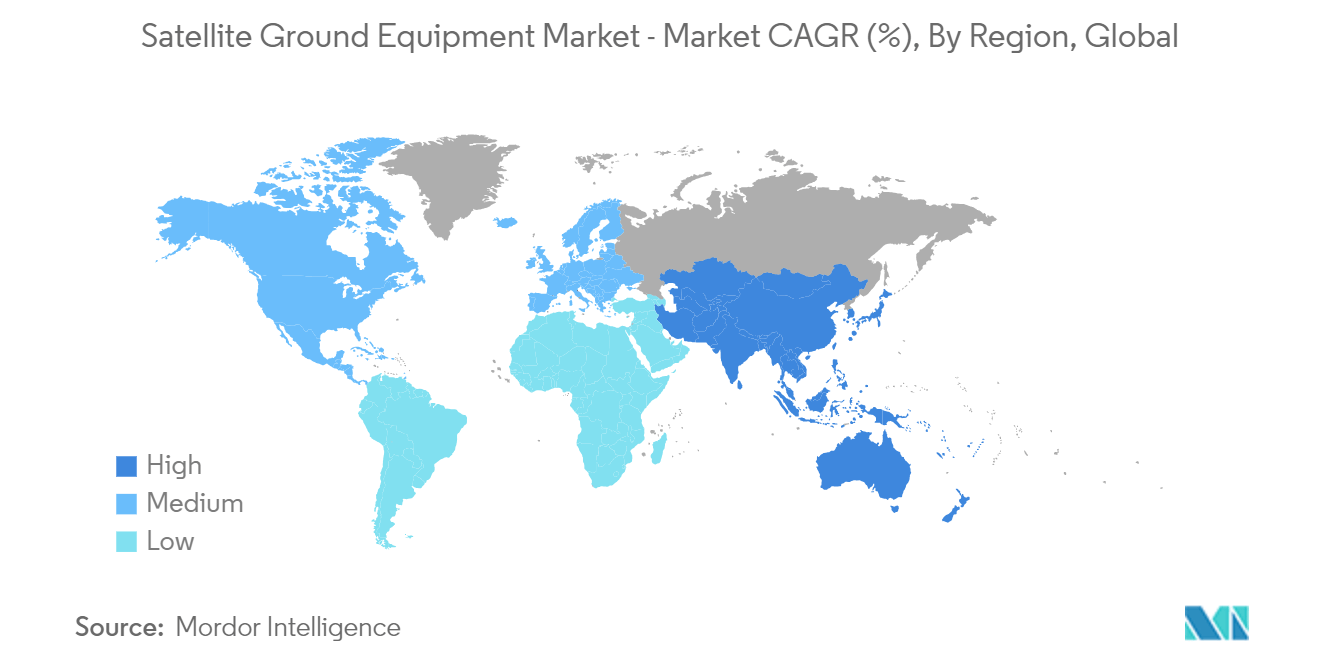Satellite Ground Equipment Market Analysis
The Satellite Ground Equipment Market size is estimated at USD 58.76 billion in 2025, and is expected to reach USD 104.11 billion by 2030, at a CAGR of 12.12% during the forecast period (2025-2030).
- The satellite ground equipment industry has grown dramatically due to advancements in radio communication solutions, such as NOC equipment, the increasing demand for mobile radio communications, and the significant deployment of public safety applications. Furthermore, the profitable introduction of low earth orbit (LEO) satellite systems, high throughput satellites (HTS), and Ku- and Ka-band satellites are adding to the lucrative growth opportunities in the market. Simultaneously, the humongous demand for autonomous and connected vehicles used for various applications in the sectors, including commercial government and defense, require sophisticated customized SATCOM-on-the-move antennas for highly trusted operation, driving the Satellite Ground Equipment Market.
- The Satellite Industry Association (SIA) reported that the ground equipment revenues have significantly increased, with the extension in the GNSS markets and network equipment, flat or somewhat declining customer equipment investments and resources, manifesting that mobile satellite services will become a fundamental growth point of the overall market studied. Passengers using a smartphone or laptop in the air can benefit from in-flight connectivity to access the internet or video streaming services. Ship personnel may benefit from crew connectivity with the latest maritime information, such as chart updates, engine monitoring, and weather routing broadcast. The backpack terminals must be quickly and reliably deployed to support connectivity in harsh and emergent conditions.
- A High Throughput Satellite (HTS) is a satellite that provides high throughput compared with a fixed satellite system for the same amount of allocated frequency on orbit. HTS reuses the frequency and multiple spot beams to improve throughput and reduce the cost per bit delivered. HTS is primarily deployed to provide broadband Internet access service to unserved regions. Most HTS satellites are designed mainly for the enterprise, telecom, or maritime sectors. Space and satellite system providers are launching HTS satellites for high-speed communication services. The increasing HTS launches increase the adoption of ground station equipment , thereby driving the market.
- Satellite broadcasting is the distribution of multimedia content or broadcast signals over or through a satellite network. The broadcast signals usually originate from a station such as a TV or radio station. Then they are sent via a satellite uplink (uploaded) to a geostationary artificial satellite for redistribution or retransmission to other predetermined geographic locations through an open or secure channel. Direct broadcasting or satellite television has become an effective form of distribution for television content. The broad and controllable coverage areas and much larger bandwidths enable more channels to be broadcast, making satellite television very attractive.
- Furthermore, there is a diversity of satellite dish heaters and satellite antenna de-icing systems on the market in the present scenario, providing enough opportunities for everything from 18” residential satellite television and satellite Internet dish antennas to larger commercial and enterprise VSAT uses. Collecting snow and/or ice on a satellite television or satellite Internet dish can cause signal loss. The satellite de-icing system is one way to stop snow and ice from accumulating on satellite dishes.
- On the contrary, the multi-band terminals used by the Navy, which come with Advanced-EHF satellites, are quite expensive. Furthermore, the cost of purchasing and installing the terminals can be anywhere from 20 to 30 times that of the rockets and spacecraft. The fact that satellite and terminal development initiatives are carried out separately has long been a source of waste and cost overruns. For example, the Air Force may oversee spacecraft while the Army may oversee radios. Rarely do earth-bound communication equipment and satellites reach the conclusion of their development cycles at the same time. The high cost of satellite ground equipment services is limiting the market's expansion.
Satellite Ground Equipment Market Trends
Defense and Government is Expected to Hold Significant Share of the Market
- The defense segment's market share is expected to expand significantly. The growing investment in satellite technology for weapons, regional security, surveillance, and espionage intelligence is anticipated to benefit the market.Several applications of satellite-based imaging include navigation, mapping and GIS, emergency and safety, geo marketing and advertising, enterprise applications, sports, augmented reality/games, mHealth, personal tracking, and social networking. All these applications are being tailormade to satisfy different needs and usage conditions. The rise of context-aware applications and augmented reality apps, coupled with the increasing shipments of devices with location-based services, is expected to further augment the market during the forecast period.
- In September 2023, United Arab Emirates (UAE) company Yahsat has been awarded a significant AED18.7 billion (USD5.1 billion) deal to provide satellite services to the UAE government. Under the 17-year Authorisation to Proceed (ATP) agreement, Yahsat will supply the government with secure and reliable satellite capacity afforded by the Al Yah 1 and Al Yah 2 satellites from 2026 onwards. The announcement said this will be supplemented by two new planned satellites – Al Yah 4 and Al Yah 5 – expected to launch in 2027 and 2028, respectively. In 2024, Yahsat will receive an advance payment of USD1 billion from the UAE government under the mandate agreement. The ATP mandate will replace existing agreements, the Capacity Services Agreement and the Managed Services Mandate (MSM), expected to conclude in November and December 2026.
- In November 2023, Aerospace and defense solutions provider Tata Advanced Systems Ltd announced it has partnered with Satellogic Inc. to establish and develop local space technology capabilities in India. The partnership with Satellogic, a player in sub-metre resolution Earth Observation (EO) data collection, is a first step in the company's satellite strategy.
- GOVSATCOM is part of the EU Space Programme (2021-2027), which uses space’s capabilities in the field of satellite communications to enable and facilitate the implementation of Member States’ or EU policies connected to citizen security. In regions with no ground infrastructure (e.g., sea, air, rural areas, the Arctic region), or if the current ground infrastructure is unstable, damaged, or destroyed, access to GOVSATCOM is essential (e.g., due to natural disasters, crises, conflicts). Further, According to the Broadband India Forum, the new standard for Interface Requirements for Communication & Broadcast Networks for fixed-satellite service-FSS/broadcasting-satellite service-BSS (mandatory technical requirements) will allow the ground segment very-small-aperture terminal (VSAT) players to take advantage of the latest SATCOM technologies (BIF).
- The market studied is expected to grow in the future due to an increase in demand for the Internet of Things (IoT) and autonomous systems and a rise in demand for military and defense satellite communication solutions. During the period, however, cybersecurity risks to satellite communication and interference in satellite data transmission are expected to stifle the market growth. Furthermore, future technological advances in satellite missions and the deployment of a 5G network via satellites will likely provide profitable prospects for the industry. Accorindg to Nato, In 2023, Poland's defense spending as a share of gross domestic product was 3.9 percent, the highest of all NATO member states, followed by the United States at 3.49 percent.
North America to Hold Major Share During the Forecast Period
- Government agencies in North America have been among the leaders in adopting advanced communication technologies. Owing to the combined efforts of public and private entities, the North American region, especially the United States, has been among the leaders in introducing new satellite and navigation systems that boosted the growth of the satellite ground equipment industry in North America.
- North America has a large coastal area that requires continuous monitoring. The increasing commercial activities and trade in the region are also propelling the need for maritime safety and surveillance. Furthermore, the underlying threat poses unique and critical challenges in enforcing maritime safety, as illegal activities can happen from all directions across the country's maritime borders if there is no proper system for detection and identification. Hence, the factors mentioned above are anticipated to influence the market studied in the region during the forecast period.
- Furthermore, the United States is the world's largest military spender. For instance, in FY 2022, the Senate Armed Services Committee approved a defense budget of about USD 25 billion higher than the President's proposal. According to SIPRI, in 2022, the total defense expenditure of the United States reached USD 876.94 billion, compared to USD 682.49 billion in 2018. Such trends favor the studied market's growth in the United States.
- Several government-led initiatives focused on leveraging the benefits of communication satellites also creates a favorable outlook for the growth of the studied market in North America. For Instance, in January 2022, the Minister of Innovation, Science and Technology of Canada announced a USD 8 million commitment in 21 organizations across Canada to explore new solutions that address Earth observation concerns and sustainable development priorities. The money will come from the Canadian Space Agency's (CSA) smartEarth program, which aims to push Canadian businesses to solve difficulties utilizing satellite data and help solve real-world concerns.
- Furthermore, the growing demand is encouraging the vendors to expand their offerings in the North American region which is also contributing to the growth of the studied market. For instance, in April 2023, Rogers Communications partnered with Lynk Global to test and deliver satellite-to-phone connectivity solutions across Canada.
Satellite Ground Equipment Industry Overview
The satellite ground equipment market is semi-consolidated owing to the presence of major players like Thales Group, Inmarsat Global Limited, Iridium Communications Inc., Gilat Satellite Networks Ltd, and Orbcomm Inc., as well as the growing entry of new players. Vendors in the market are adopting strategies such as innovations, partnerships, mergers, and acquisitions to enhance their product offerings and gain a sustainable competitive advantage.
- In May 2023, Low Earth Orbit satellite firm OneWeb is set to establish a ground station on the island of St. Helena and take ability on the island’s trunk of the Equiano subsea cable. OneWeb has inscribed a 10-year ground station agreement with regional telco Sure. OneWeb is set to construct a ground station at Horse Point, with Sure set to manage the facility. The ground station will then be connected via fiber to the island’s cable dock station at Rupert’s Beach.
- In March 2023, India-based full-stack space-engineering solutions company Dhruva Space and France-based satellite operator and global connectivity provider Kineis have inked a Memorandum of Agreement (MoA), marking a collaboration where both organizations will collaborate to launch space and ground infrastructure to scale the variety and impact of satellite-based solutions. With nine satellites in orbit, Kineis’ operational services provide global worldwide coverage.
Satellite Ground Equipment Market Leaders
-
Thales Group
-
Inmarsat global limited
-
Iridium Communications Inc.
-
Gilat Satellite Networks Ltd
-
Orbcomm Inc.
- *Disclaimer: Major Players sorted in no particular order
Satellite Ground Equipment Market News
- February 2023 - CobhamSatcom and RBC Signals, a global satellite data communication solutions provider, announced an extended agreement to deploy CobhamSatcom's adaptable Tracker 6000 and 3700 series ground stations worldwide. The collaborative partnership between the two parties would dramatically expand RBC Signals' vast owned and partner ground network, providing integrated communication services to NGSO missions and constellations for Earth Observation, IoT, and Space Situational Awareness.
- February 2023 - China Aerospace Science and Technology Corporation (CASC) announced the successful launch of the Zhongxing-26 communications satellite. Based on the DFH-4E satellite bus, the satellite is China's first, providing a speed of more than 100 gigabits per second (Gbps).
Satellite Ground Equipment Industry Segmentation
Satellite ground equipment refers to the infrastructure and devices necessary for the reception, processing, and transmission of signals to and from satellites. These ground stations are pivotal for satellite-based communication, broadcasting, navigation, and earth observation purposes.
The Satellite Ground Equipment Market is segmented by Type (Ground Equipment, Service), End-User Vertical (Maritime, Defense and Government, Enterprises, Media and Entertainment, and Other End-Users), Geography (North America, Europe, Asia-Pacific, Latin America, Middle East & Africa). The market size and forecasts are provided in terms of value in USD for all the above segments.
| By Type | Ground Equipment |
| Service | |
| By End-user Vertical | Maritime |
| Defense and Government | |
| Enterprises | |
| Media and Entertainment | |
| Other End-user Verticals | |
| By Geography | North America |
| Europe | |
| Asia-Pacific | |
| Latin America | |
| Middle East and Africa |
Satellite Ground Equipment Market Research FAQs
How big is the Satellite Ground Equipment Market?
The Satellite Ground Equipment Market size is expected to reach USD 58.76 billion in 2025 and grow at a CAGR of 12.12% to reach USD 104.11 billion by 2030.
What is the current Satellite Ground Equipment Market size?
In 2025, the Satellite Ground Equipment Market size is expected to reach USD 58.76 billion.
Who are the key players in Satellite Ground Equipment Market?
Thales Group, Inmarsat global limited, Iridium Communications Inc., Gilat Satellite Networks Ltd and Orbcomm Inc. are the major companies operating in the Satellite Ground Equipment Market.
Which is the fastest growing region in Satellite Ground Equipment Market?
Asia-Pacific is estimated to grow at the highest CAGR over the forecast period (2025-2030).
Which region has the biggest share in Satellite Ground Equipment Market?
In 2025, the North America accounts for the largest market share in Satellite Ground Equipment Market.
What years does this Satellite Ground Equipment Market cover, and what was the market size in 2024?
In 2024, the Satellite Ground Equipment Market size was estimated at USD 51.64 billion. The report covers the Satellite Ground Equipment Market historical market size for years: 2019, 2020, 2021, 2022, 2023 and 2024. The report also forecasts the Satellite Ground Equipment Market size for years: 2025, 2026, 2027, 2028, 2029 and 2030.
Our Best Selling Reports
Satellite Ground Equipment Industry Report
Statistics for the 2025 Satellite Ground Equipment market share, size and revenue growth rate, created by Mordor Intelligence™ Industry Reports. Satellite Ground Equipment analysis includes a market forecast outlook for 2025 to 2030 and historical overview. Get a sample of this industry analysis as a free report PDF download.

_Market_Major_Players_Logo.webp)





